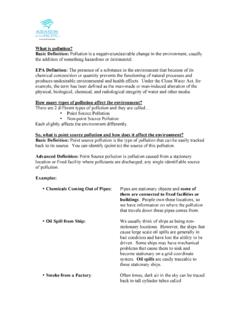Transcription of State of the global market for shark products
1 FAO. ISSN 2070-7010. FISHERIES AND. AQUACULTURE. 590. TECHNICAL. PAPER. 590. State of the global market for shark products State of the global market for shark products This publication is intended to complement and inform the International Plan of Action for the Conservation and Management of Sharks, developed in 1998 to address concerns over possible negative effects of increased shark catches on vulnerable shark populations. It is also intended as a part complement to, and part continuation of, shark Utilization, Marketing and Trade (FAO Fisheries Technical Paper No. 389), published in 1999. Much of that paper remains valid, the information on product utilization and processing, as well as that on the biological characteristics of shark species. Consequently, the present publication focuses primarily on providing an updated picture of the world market for shark products using data that in many cases have only become available in recent years, such as origin and destination data.
2 Where data are still lacking, an effort has been made to estimate the relevant figures through examination of the trade databases of the world's major traders of shark products . This increased availability of data is believed to have allowed a more accurate and up-to-date initial evaluation of the relative importance of each country or territory, thus providing a more solid basis on which to target investigative efforts. The country-by-country assessments of shark fin trade recording practices also constitute another important area of focus that had not previously been addressed. However, given the primary objective of this study (above), those details that are necessarily not captured in such a broad-scale review will need to be identified and elucidated in regional or country-specific studies. FAO. Cover photograph: Blacktip reef shark , Barcelona's aquarium .
3 Spain. FAO/Alessia Pierdomenico. State of the global market for FAO. FISHERIES AND. AQUACULTURE. shark products TECHNICAL. PAPER. 590. Felix Dent Fishery Industry Officer products , Trade and Marketing Branch FAO Fisheries and Aquaculture Department Rome, Italy and Shelley Clarke Technical Coordinator-Sharks and Bycatch ABNJ (Common Oceans) Tuna Project Western and Central Pacific Fisheries Commission Pohnpei, The Federated States of Micronesia FOOD AND AGRICULTURE ORGANIZATION OF THE UNITED NATIONS. Rome, 2015. The designations employed and the presentation of material in this information product do not imply the expression of any opinion whatsoever on the part of the Food and Agriculture Organization of the United Nations (FAO) concerning the legal or development status of any country, territory, city or area or of its authorities, or concerning the delimitation of its frontiers or boundaries.
4 The mention of specific companies or products of manufacturers, whether or not these have been patented, does not imply that these have been endorsed or recommended by FAO in preference to others of a similar nature that are not mentioned. The views expressed in this information product are those of the author(s) and do not necessarily reflect the views or policies of FAO. ISBN 978-92-5-108823-4. FAO, 2015. FAO encourages the use, reproduction and dissemination of material in this information product . Except where otherwise indicated, material may be copied, downloaded and printed for private study, research and teaching purposes, or for use in non-commercial products or services, provided that appropriate acknowledgement of FAO as the source and copyright holder is given and that FAO's endorsement of users' views, products or services is not implied in any way.
5 All requests for translation and adaptation rights, and for resale and other commercial use rights should be made via or addressed to FAO information products are available on the FAO website ( ). and can be purchased through iii Preparation of this document This publication is intended to complement and inform the International Plan of Action for the Conservation and Management of Sharks, developed in 1998 to address concerns over possible negative effects of increased shark catches on vulnerable shark populations. It is also intended as a part complement to, and part continuation of, shark Utilization, Marketing and Trade (FAO Fisheries Technical Paper No. 389), published in 1999. Much of that paper remains valid, the information on product utilization and processing, as well as that on the biological characteristics of shark species.
6 Consequently, the present publication focuses primarily on providing an updated picture of the world market for shark products using data that in many cases have only become available in recent years, such as origin and destination data. Where data are still lacking, an effort has been made to estimate the relevant figures through examination of the trade databases of the world's major traders of shark products . This increased availability of data is believed to have allowed a more accurate and up-to-date initial evaluation of the relative importance of each country or territory, thus providing a more solid basis on which to target investigative efforts. The country-by-country assessments of shark fin trade recording practices also constitute another important area of focus that had not previously been addressed. However, given the primary objective of this study (above), those details that are necessarily not captured in such a broad-scale review will need to be identified and elucidated in regional or country-specific studies.
7 Iv Abstract Even as the total declared value of world trade in shark products approaches USD1 billion traded per year, the State of knowledge of this increasing globalized market remains limited. This technical paper attempts to address some of the remaining information gaps. Specifically, the investigative efforts focus primarily on the available quantitative and qualitative data relating to the key market characteristics of the major traders of shark products and their trading partners. For the purposes of the publication, the world shark trade is most efficiently described in terms of the two most-traded products : shark fins and shark meat. Hence, the report is accordingly divided into two parts. Each individual country section includes a summary of the role and the relative importance of the country or territory in the global market , combined with a description of the specifics of the trade flows between it and its major trading partners, and an analysis of the apparent trends as reflected in trade statistics.
8 Where appropriate, the section dealing with trade is complemented by an analysis of domestic trade and markets within the relevant country or territory. As no in-depth field studies were conducted to gather data specifically for this publication, its focus is necessarily on the existing trade records of the world's major traders of shark products and, in the case of the domestic trade and market sections, on primarily qualitative information from a variety of sources, compiled with the assistance of the IUCN shark Specialist Group. This technical paper also attempts to identify specific problems with current trade recording mechanisms, specifically with regard to their suitability for gathering detailed, consistent and accurate data on the trade in shark products . The issues in question, considered to be more widespread and pertinent in the case of shark fins, include missing data, miscoded or aggregated products , and the difficulty of identifying what proportion of traded quantities, or changes in these quantities over time, is the result of double-counting or modification by processing.
9 This State of affairs itself represents an area where more analysis and research are needed in order to assess the appropriateness and effectiveness of current trade recording mechanisms, both for the purpose of describing and analysing the world market for shark -derived products and also for the further purpose of facilitating the monitoring of trade in CITES-listed species. As such, this publication includes, in addition to its market description and analysis component, a country-by-country evaluation of the trade recording systems for shark fins currently in place in major shark markets and producing countries. Where judged necessary, this is combined with an assessment of the likely reliability of the associated data. Finally, this technical paper offers a concise set of expert recommendations directed at international organizations, regional fisheries management bodies, national authorities and the industry itself, each of which seeks to advance the common goal of ensuring the sustainable utilization of shark populations.
10 These recommendations represent practical policy and industry responses to the most important issues and challenges that have arisen from the current knowledge of the State of the global market for shark products , further informed by the findings of this paper. Dent, F. & Clarke, S. 2015. State of the global market for shark products . FAO Fisheries and Aquaculture Technical Paper No. 590. Rome, FAO. 187 pp . v Contents Preparation of this document iii Abstract iv Abbreviations and acronyms vii Acknowledgements viii 1. Introduction 1. Overview 1. shark fins 3. shark meat 3. Information gaps and data paucity 4. 2. Key issues, trends and recommendations 5. Key issues and trends 5. Aggregate trends in shark fins and shark meat 5. Trends in shark fins based on key trade centres 6. Trends in shark meat based on key trade centres 6.

















